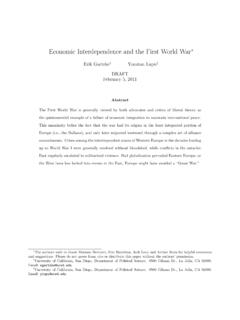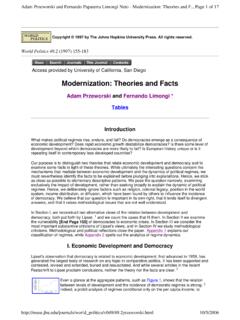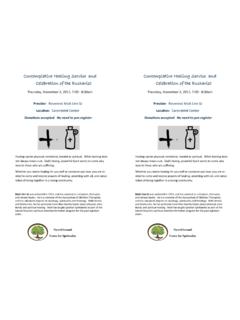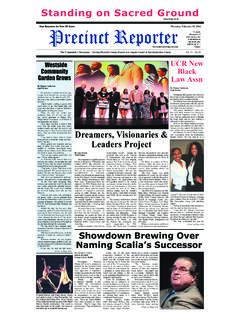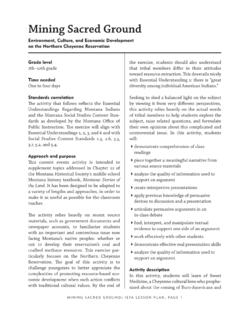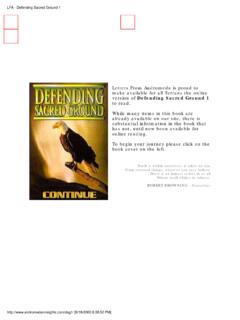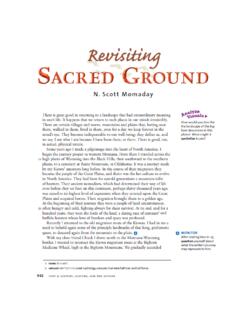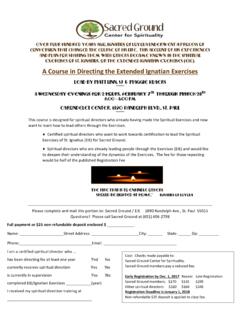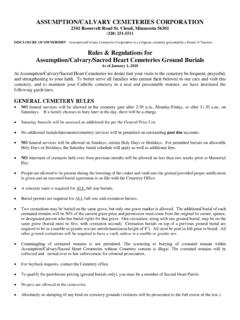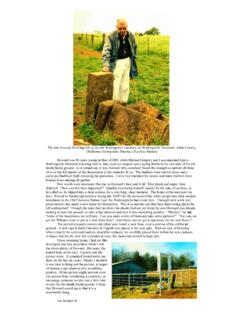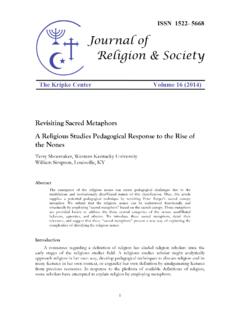Transcription of Dwelling on Sacred Ground - pages.ucsd.edu
1 6/4/09 1:38 Dwelling on Sacred GroundPage 1 of 7 on Sacred GroundBy Yelena Akopian, Senior Staff WriterMansions built atop ancient American-Indian burial grounds are the stuff of legends. But justoff campus on Regents Road, that stereotype is more fact than literally on top of an ancient American-Indian cemetery UCSD s records show 29human remains have been removed from the chancellor s historic residence over the past 80years the University House was declared unlivable in 2004 due to hazards and approximately 10,000-year-old bones of the two adults were dug up from the property in1976 by Cal State Northridge archeology students. The two skeletons are frozen in a uniquearrangement, with a young man buried at the feet of an older woman. They are among theoldest skeletal remains yet discovered in the Western Hemisphere, and form the only doubleburial of their kind in the Kumeyaay Cultural Repatriations Committee (KCRC), a group of federally recognized SanDiego tribes, submitted a request to the university in 2006 asking for the remains to berepatriated or returned to the Kumeyaay KCRC asserted that their ancestors have been here since time immemorable, and saidthey intend to rebury the remains if they are Native American Grave Protection and Repatriation Act (NAGPRA), federal legislationpassed in 1990, details the official guidelines by which human remains can be identified andreturned to American-Indian tribes that request NAGPRA states that remains must be expeditiously returned when a tribe can provecultural affiliation.
2 This occurs when a preponderance of the evidence based ongeographical, kinship, biological, archeological, linguistic, folklore, oral tradition, historicalevidence, or other information or expert opinion reasonably leads to such a conclusion. In 2008, a UCSD panel assigned with the task of determining cultural affiliation concluded thatthe bones were culturally unidentifiable. The panel submitted a report that said, Our finding6/4/09 1:38 Dwelling on Sacred GroundPage 2 of 7 that there is not a significant preponderance of evidence to support an affirmation of culturalidentification or affiliation with any modern group. The KCRC found this highly offensive. We know that they are culturally identifiable, KCRC spokesman Steve Banegas said. All wewant is to merely rebury them, and respect them, and treat them as the human beings that theyonce were. Banegas criticized the way the university has continued to handle the situation.
3 This institution is supposed to be teaching people about values and learning and understanding,and wanting to stretch their hand out to the Kumeyaay nation, he said. But they refuse to sitand talk with us as equals, and we re not going to get anywhere until that happens. Ross Frank, a UCSD professor and chair of the ethnic studies department, presented the singledissenting view in the panel. He said the methodology used by the committee was flawedbecause it looked at each piece of evidence presented by the Kumeyaay in an isolated to Frank, evaluating pieces of evidence independently from each other iscontradictory to the language and spirit of NAGPRA. He said that evaluating all the pieces ofevidence as a whole would weave a kind of tapestry that supports cultural affiliation. If you did that, and did that in an interdisciplinary manner, using both scientific and socialscientific methods, you could reasonably come to a conclusion that there is, in fact, a culturalaffiliation, he also pointed out that the review committee did not have any native representation, andhis minority report strongly supported cultural Schoeninger, anthropology professor and head of the review committee, defended herdesignation of the bones as unidentifiable.
4 We had taken the whole thing together, Schoeninger said. What bothers me extremelydeeply is the dismissal of an evidence-based belief system and the privileging of a belief-basedsystem. I don t doubt that the people are genuine, nor do I have a lack of respect. But they rebeliefs, they re feelings .. NAGPRA is not based on deeply held feelings. A UC-wide committee later confirmed the original committee s majority ruling of the bones asculturally unidentifiable, dashing most hopes the KCRC had of 1:38 Dwelling on Sacred GroundPage 3 of 7 is, until a request from Vice Chancellor of Resource Management and Planning GaryMatthews was submitted to UC Office of the President late last May, asking for arecommendation to the federal Department of the Interior to repatriate the bones. I believe that the wisest, most appropriate and most respectful action to take at this pointwould be to repatriate, Matthews staid in the letter.
5 Doing so would achieve an outcome thatis consistent with NAGPRA. Moreover, it would balance the scientific benefit that has alreadybeen achieved with the value of recognizing the sincere and profoundly held cultural views thathave been expressed by the representatives of the Kumeyaay Nation in San Diego. Matthews also pointed out that repatriation could assist the university s push to increasediversity. Currently, less than 1 percent of the UCSD student body is American-Indian, none ofwhom are approval of Matthews request would return the bones to KCRC, it would not overturnthe committee s ruling that the remains are culturally unidentifiable. For this reason, leaders ofthe KCRC do not officially back the statement issued by the KCRC in early May stated that the Kumeyaay have provided theuniversity with a mountain of evidence from linguistic, anthropological, archaeological andhistorical scholars to support their statement said that accepting the remains as culturally unidentifiable sets a dangerousprecedent for future claims, both from KCRC and other tribes whose ancestors may be in thepossession of the UC.
6 Banegas said he feels the university should admit the remains rightfully belong to theKumeyaay, and is offended to be asked for proof of something he feels is obvious. They give the impression that they want to give [the remains] back, but yet they have all theseconditions, Banegas said. They ve given the impression that all we have to do is take themback and everything will go away, and that s not true. For some odd reason, they don t seem tothink that they re our ancestors .. What they re basing this on, I don t know, other than a fewpeople not wanting to repatriate for whatever reason. According to Science magazine, Schoeninger and members of the American Association ofPhysical Anthropologists sent a letter to the Department of the Interior claiming the bones aretoo important to be April, at the annual meeting of the AAPA, Schoeninger made a presentation on the bones 6/4/09 1:38 Dwelling on Sacred GroundPage 4 of 7 , Frank said the belief that scientists will be able to study the bones if they are notreturned to the KCRC is merely a presumption.
7 If they find that they re culturally unaffiliated, that doesn t say anything about what happens tothe bones, Frank said. What we have here is a system that assumes that it has the privilege ofstudying scientifically anything that s not repatriated. A few weeks after sending the letter to the Department of the Interior, university administratorsofficially withdrew the request, citing lack of support from the Kumeyaay. When we learned that the Kumayeey Cultural Repatriation Committee did not support theuniversity s request submitted to the federal NAGPRA review committee to repatriate theremains the university withdrew its request, UCSD spokeswoman Stacie Spector skeletons currently remain in university Chancellor of Research Art Ellis is in charge of drawing up a set of guidelines for curatingand studying the bones. Ellis was unable to comment as of press time. The next move is up to them, Banegas said.
8 We ve put in a number of requests and they vedenied them. We ll have to see. Readers can contact Yelena Akopian at 2008 - on June 1st, 2009 by hunwutFiled under: Education, Repatriation, ReservationsLeave a ReplyYou must be logged in to post a comment. Just Because the Name is Legal Doesn t Make it Right American Indians and Palestinians:Parallel Injustice Search Search6/4/09 1:38 Dwelling on Sacred GroundPage 5 of 7 inEntries RSSC omments RSSMenuHomeCategoriesAlertArtArticleBlog rollBook ReviewCommunityEventsLaw and OrderObituariesCultureEducationEnvironme ntExhibitFederal GovernmentGamingHealingHealthHistoryHote l & ResortsIndian child welfareInterestingJob OfferLandLanguage6/4/09 1:38 Dwelling on Sacred GroundPage 6 of 7 AlertMuseumMusicNewsOpinionRepatriationR eservationsSite NewssovereigntySportsState GovernmentUncategorizedWild FiresArchivesJune 2009 May 2009 April 2009 March 2009 February 2009 January 2009 December 2008 November 2008 October 2008 September 2008 August 2008 July 2008 June 2008 May 2008 April 2008 March 2008 February 2008 January 2008 December 2007 November 2007 October 2007 September 20076/4/09 1.
9 38 Dwelling on Sacred GroundPage 7 of 7 2007 July 2007 June 2007 May 2007 April 2007 March 2007 February 2007 January 2007 November 2006 October 2006 September is proudly powered by WordPress Design by.
